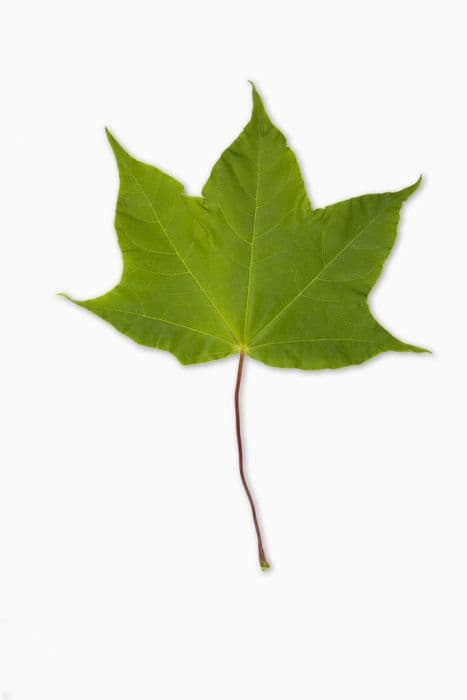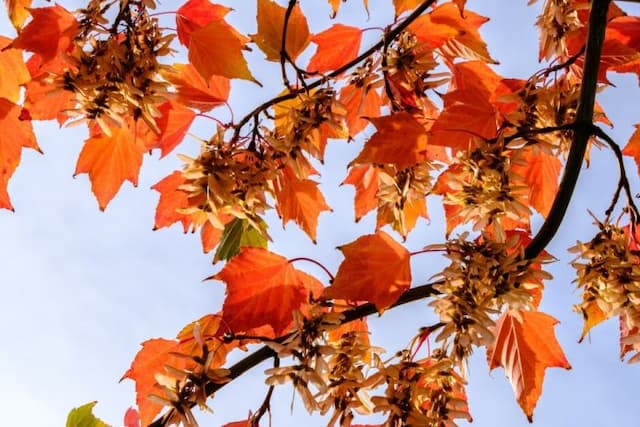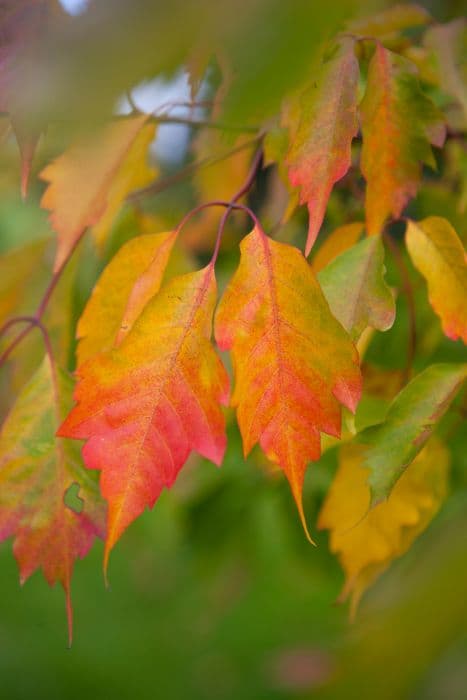Trautvetter's Maple Acer trautvetteri

ABOUT
The plant in question, commonly known as the Trautvetter's Maple, exhibits a distinct appearance. The leaves of the Trautvetter's Maple are typically palmately lobed, meaning they have several finger-like lobes spreading out from a central point. Each leaf generally has a radiant green color which can change to a vivid orange or red when autumn arrives, making it a stunning sight during the fall season. The bark of the Trautvetter's Maple is another characteristic attribute, usually displaying a smooth texture when the plant is young, but becoming more rough and scaly as the plant ages. This progression in bark texture adds a visual depth to the plant over time. Flowering in the early spring before the leaves fully emerge, the flowers can be quite inconspicuous, often green or yellow-green, they hang in clusters giving a subtle decorative effect to the plant. Following the flowers, the seeds develop into winged samaras, which are essentially small, paired, papery wings that can be carried away by the wind. These samaras are characteristic of many maple species, and not only aid in seed dispersal but also add a whimsical element to the plant's overall look. Overall, the Trautvetter's Maple presents itself as a plant with a lush foliage display, interesting textural bark, and unobtrusive yet charming flowers and seeds, contributing to its ornamental appeal.
About this plant
 Names
NamesSynonyms
Trautvetter's Maple, Caucasus Maple, Persian Maple.
Common names
Acer trautvetteri Medw., Acer intermedium var. trautvetteri (Medw.) Pax
 Toxicity
ToxicityTo humans
Acer trautvetteri, commonly known as the Caucasian maple, does not have a well-documented profile of toxicity to humans. There are no widespread reports or scientific data indicating that this particular maple species is hazardous if ingested. It's always wise to exercise caution and avoid consuming plants not known to be safe, but as of the current knowledge, there are no specific symptoms of poisoning associated with the Caucasian maple for humans.
To pets
There is limited information on the toxicity of Caucasian maple (Acer trautvetteri) specifically to pets. Most maple species are not well-known for being highly toxic to animals, but some maples, like the red maple (Acer rubrum), can be harmful to pets, especially horses, if ingested in large quantities. The symptoms of red maple poisoning in horses include weakness, anemia, and dark brown urine, among others. As a general precaution, prevent pets from ingesting large quantities of any plant material. If you suspect your pet has ingested parts of a Caucasian maple or any other potentially harmful plant, consult a veterinarian.
 Characteristics
CharacteristicsLife cycle
Perennials
Foliage type
Deciduous
Color of leaves
Green
Height
30 40 feet (9 12 meters)
Spread
20 30 feet (6 9 meters)
Plant type
Tree
Hardiness zones
5
Native area
Caucasus
Benefits
 General Benefits
General Benefits- Ecosystem Support: Provides habitat and food for a variety of wildlife, including birds and insects.
- Ornamental Value: Acer trautvetteri, commonly known as the Caucasian maple, has attractive foliage and a pleasing shape that enhances landscape aesthetics.
- Shade Production: Its broad canopy offers shade, which can reduce local temperatures and create comfortable outdoor spaces.
- Soil Stabilization: The root system helps prevent soil erosion in landscapes and natural settings.
- Cultural Significance: In some cultures, the tree may have symbolic importance or be used in traditional practices.
- Wood Resource: Provides timber that can be used for furniture, flooring, and other woodworking projects.
 Medical Properties
Medical PropertiesThis plant is not used for medical purposes.
 Air-purifying Qualities
Air-purifying QualitiesThis plant is not specifically known for air purifying qualities.
 Other Uses
Other Uses- Acer trautvetteri, commonly known as the Trautvetter's Maple, can be used in woodworking for specialty items due to its fine grain and attractive wood pattern.
- The wood of Trautvetter's Maple is sometimes utilized in the production of musical instruments for its acoustic properties.
- Leaves of the Trautvetter's Maple might be employed in decorative arts for leaf impressions or natural patterns in eco-printing techniques.
- The tree can serve as an educational tool in dendrology and botany studies because of its unique characteristics among maple species.
- Due to its robustness in various climates, this maple can be used in urban landscaping as a street or park tree.
- Its sap can be tapped for syrup production similarly to other maple species, although it is not commonly used for this purpose.
- The resilient bark of Trautvetter's Maple can be a source of tannins, which might be utilized in small-scale leather tanning processes.
- With its vibrant fall foliage, the tree is well-suited for ornamental use in gardens dedicated to autumn colors.
- In crafting, small branches and twigs can be used to create rustic furniture or decorative frames.
- Due to its tall and straight growth, the wood can be used for making poles or tool handles that require durability and a strong grip.
Interesting Facts
 Feng Shui
Feng ShuiThe Acer trautvetteri, commonly known as the Caucasian maple, is not used in Feng Shui practice.
 Zodiac Sign Compitability
Zodiac Sign CompitabilityThe Caucasian maple is not used in astrology practice.
 Plant Symbolism
Plant Symbolism- Resilience: Acer trautvetteri, commonly known as the Caucasian Maple, often symbolizes resilience due to its ability to thrive in a variety of soils and conditions.
- Growth: The steady growth of the Caucasian Maple represents personal growth and the pursuit of one's ambitions with determination.
- Protection: With its wide canopy, the tree is often associated with protection and shelter, offering a safe haven to those under its boughs.
- Adaptability: Its capacity to adapt to different environments makes the Caucasian Maple a symbol of adaptability and the ability to thrive in various circumstances.
 Water
WaterThe Caucasian Maple should be watered deeply and regularly during its first growing season to establish an extensive root system. Once established, reduce frequency, but continue providing regular waterings during dry spells. Watering with 1 to 1.5 inches of water once a week is generally sufficient, but this may need to be adjusted depending on climate and soil conditions. Overhead watering or using a drip irrigation system can ensure even moisture distribution. Avoid overwatering which can lead to root rot; the soil should be allowed to dry out slightly between watering.
 Light
LightThe Caucasian Maple thrives in full sun to partial shade. It's adaptable to various light conditions, but for best growth and health, choose a location where the tree will receive sunlight for at least part of the day, ideally in the morning. Avoid deep shade conditions as this can lead to poor leaf color and weak growth.
 Temperature
TemperatureThe Caucasian Maple prefers temperate climates and can tolerate a range of temperature conditions. It can survive winter lows down to about -20 degrees Fahrenheit, but the ideal growing temperature range is between 60 to 70 degrees Fahrenheit during the growing season. Extreme heat can stress the plant, so in regions with hot summers, some afternoon shade can be beneficial.
 Pruning
PruningPrune the Caucasian Maple to maintain its health and desired shape, typically during the dormant season. Pruning in late winter or early spring before new growth starts is ideal. Remove any dead, damaged, or crossing branches, and thin out the canopy as needed to allow light and air to penetrate, which helps prevent disease. Annual pruning can encourage more vigorous growth.
 Cleaning
CleaningAs needed
 Soil
SoilFor the Red Maple (Acer trautvetteri), the best soil mix is one that is well-draining yet moisture-retentive; a mixture of loamy soil, peat, and coarse sand or perlite is ideal. The soil pH should be slightly acidic to neutral, ranging from 5.5 to 7.5 for optimal growth.
 Repotting
RepottingRed Maples (Acer trautvetteri) should be repotted every two to three years to ensure they have sufficient space for root growth and access to nutrients. Younger trees may require more frequent repotting, while mature trees can be repotted less often.
 Humidity & Misting
Humidity & MistingRed Maples (Acer trautvetteri) prefer moderate to high humidity levels, ideally between 40% to 75%. Maintaining sufficient humidity is important for their wellbeing, particularly if the plant is grown indoors.
 Suitable locations
Suitable locationsIndoor
Place Red Maple in bright, indirect light; keep soil evenly moist.
Outdoor
Plant in well-drained soil, partial to full sun, protect from strong winds.
Hardiness zone
5-7 USDA
 Life cycle
Life cycleAcer trautvetteri, known as the Caucasian maple, begins its life cycle with seed germination, typically occurring in spring when soil temperatures rise. The germinated seedlings grow into juvenile plants, developing a basic root system and beginning to photosynthesize with their first leaves. As the saplings mature, they undergo a period of vegetative growth, increasing in height and girth, and developing the characteristic palmate leaves of maples. The tree reaches sexual maturity after several years and starts to flower, producing inconspicuous yellowish-green flowers that are wind-pollinated. Following pollination, the flowers develop into samaras, the winged fruit characteristic of maples, which are then dispersed by wind. The Caucasian maple completes its life cycle when these seeds land in a suitable location, germinate, and grow into new trees, continuing the cycle.
 Propogation
PropogationPropogation time
Spring-Early Summer
Propogation: Acer trautvetteri, commonly known as the Trautvetter's Maple, is best propagated by seed. The optimal time for sowing the seeds of Trautvetter's Maple is in the fall, immediately after collection. When propagating by seed, it is important to mimic the natural cold stratification process by subjecting the seeds to a period of cold temperatures before they will germinate. This can be achieved by mixing the seeds with moist sand and storing them in a refrigerator at about 34 to 41 degrees Fahrenheit (1 to 5 degrees Celsius) for approximately 90 to 120 days. After stratification, the seeds can be sown in well-drained soil in a nursery bed or pots. They typically germinate in the spring following the stratification period, and once the seedlings have grown to a sufficient size, they can be transplanted to their permanent location.









